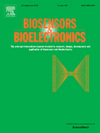
BIOSENSORS & BIOELECTRONICS
生物傳感器和生物電子學(xué)
- 期刊周期:Monthly
- 研究方向:工程技術(shù)
- 影響因子:9.518
- 通訊地址:ELSEVIER ADVANCED TECHNOLOGY, OXFORD FULFILLMENT CENTRE THE BOULEVARD, LANGFORD LANE, KIDLINGTON, OXFORD, ENGLAND, OXON, OX5 1GB
- 官網(wǎng):http://journals.elsevier.com/09565663/biosensors-and-bioelectronics/
- 投稿地址:http://ees.elsevier.com/bios/
- 審稿速度:約1.9個(gè)月
中文簡(jiǎn)介
《生物傳感器與生物電子》擁有一個(gè)開(kāi)放獲取的鏡像期刊《生物傳感器與生物電子:X》,具有相同的目標(biāo)和范圍,編輯團(tuán)隊(duì),提交系統(tǒng)和嚴(yán)格的同行審查。生物傳感器被定義為包含生物材料、生物衍生材料或生物模擬材料的分析設(shè)備,這些分析設(shè)備與物理化學(xué)傳感器或傳感微系統(tǒng)密切相關(guān)或集成在一起,可以是光學(xué)、電化學(xué)、測(cè)溫、壓電、磁性或微機(jī)械(Turner et al., 1987;特納,1989)。《生物傳感器與生物電子學(xué)》是主要的國(guó)際期刊,致力于生物傳感器和生物電子學(xué)的研究、設(shè)計(jì)、開(kāi)發(fā)和應(yīng)用。這是一個(gè)跨學(xué)科期刊服務(wù)有興趣的專業(yè)人士生物材料開(kāi)發(fā)和設(shè)計(jì)新穎的診斷和電子設(shè)備包括傳感器、DNA芯片,電子鼻子,"和μ-TAS。生物傳感器通常產(chǎn)生與特定分析物或一組分析物濃度成正比的數(shù)字電子信號(hào)。雖然信號(hào)在原則上可能是連續(xù)的,但可以將設(shè)備配置為產(chǎn)生單個(gè)測(cè)量值,以滿足特定的市場(chǎng)需求。生物傳感器的例子包括免疫傳感器、基于酶的生物傳感器、基于生物體和整個(gè)細(xì)胞的生物傳感器。它們已被應(yīng)用于各種各樣的分析問(wèn)題,包括在醫(yī)學(xué)、生物醫(yī)學(xué)研究、藥物發(fā)現(xiàn)、環(huán)境、食品、加工工業(yè)、安全和國(guó)防方面的應(yīng)用。設(shè)計(jì)和研究分子和超分子結(jié)構(gòu)與分子生物認(rèn)知和仿生性能用于分析設(shè)備也包括在該期刊的范圍內(nèi)。這里的重點(diǎn)是分子識(shí)別、納米技術(shù)、分子印跡和超分子化學(xué)之間的互補(bǔ)交叉,以提高器件的分析性能和魯棒性。新興的生物電子學(xué)領(lǐng)域?qū)で笤诟鼜V泛的范圍內(nèi),如生物燃料電池、用于信息處理、信息存儲(chǔ)、電子元件和執(zhí)行器的仿生學(xué)和生物材料方面,結(jié)合電子技術(shù)來(lái)開(kāi)發(fā)生物學(xué)。其中一個(gè)關(guān)鍵方面是生物材料與微、納米電子器件之間的接口。盡力保持連貫性在期刊的范圍,編輯會(huì)接受評(píng)論和論文明顯相關(guān)的社區(qū),它描述重要的新概念,鞏固理解字段或?qū)嶋H應(yīng)用提供重要的見(jiàn)解,制造和商業(yè)化的生物傳感器和生物電子學(xué)。
英文簡(jiǎn)介
Biosensors & Bioelectronics has an open access mirror journal Biosensors & Bioelectronics: X, sharing the same aims and scope, editorial team, submission system and rigorous peer review.Biosensors are defined as analytical devices incorporating a biological material, a biologically derived material or a biomimic intimately associated with or integrated within a physicochemical transducer or transducing microsystem, which may be optical, electrochemical, thermometric, piezoelectric, magnetic or micromechanical (Turner et al., 1987; Turner, 1989). Biosensors & Bioelectronics is the principal international journal devoted to research, design, development and application of biosensors and bioelectronics. It is an interdisciplinary journal serving professionals with an interest in the exploitation of biological materials and designs in novel diagnostic and electronic devices including sensors, DNA chips, electronic noses, lab-on-a-chip and μ-TAS. Biosensors usually yield a digital electronic signal which is proportional to the concentration of a specific analyte or group of analytes. While the signal may in principle be continuous, devices can be configured to yield single measurements to meet specific market requirements. Examples of Biosensors include immunosensors, enzyme-based biosensors, organism- and whole cell-based biosensors. They have been applied to a wide variety of analytical problems including uses in medicine, biomedical research, drug discovery, the environment, food, process industries, security and defence. The design and study of molecular and supramolecular structures with molecular biorecognition and biomimetic properties for use in analytical devices is also included within the scope of the journal. Here the focus is on the complementary intersection between molecular recognition, nanotechnology, molecular imprinting and supramolecular chemistry to improve the analytical performance and robustness of devices.The emerging field of Bioelectronics seeks to exploit biology in conjunction with electronics in a wider context encompassing, for example, biological fuel cells, bionics and biomaterials for information processing, information storage, electronic components and actuators. A key aspect is the interface between biological materials and micro- and nano-electronics.While endeavouring to maintain coherence in the scope of the journal, the editors will accept reviews and papers of obvious relevance to the community, which describe important new concepts, underpin understanding of the field or provide important insights into the practical application, manufacture and commercialisation of biosensors and bioelectronics.
近年期刊自引率趨勢(shì)圖
JCR分區(qū)
| JCR分區(qū)等級(jí) | JCR所屬學(xué)科 | 分區(qū) | 影響因子 |
| Q1 | CHEMISTRY, ANALYTICAL | Q1 | 12.545 |
| ELECTROCHEMISTRY | Q1 | ||
| BIOTECHNOLOGY & APPLIED MICROBIOLOGY | Q1 | ||
| BIOPHYSICS | Q1 | ||
| NANOSCIENCE & NANOTECHNOLOGY | Q1 |
近年期刊影響因子趨勢(shì)圖
CiteScore數(shù)值
| CiteScore | SJR | SNIP | 學(xué)科類別 | 分區(qū) | 排名 | 百分位 |
| 20.20 | 2.113 | 1.741 | 大類:Biochemistry, Genetics and Molecular Biology 小類:Biophysics | Q1 | 3 / 137 |
98% |
| 大類:Biochemistry, Genetics and Molecular Biology 小類:Biomedical Engineering | Q1 | 6 / 252 |
97% |
|||
| 大類:Biochemistry, Genetics and Molecular Biology 小類:Biotechnology | Q1 | 7 / 293 |
97% |
|||
| 大類:Biochemistry, Genetics and Molecular Biology 小類:Electrochemistry | Q1 | 2 / 45 |
96% |
相關(guān)工程技術(shù)SCI期刊推薦
- SemimonthlyADVANCED MATERIALS
- Journal of Materials Chemistry A
- MonthlyADVANCED FUNCTIONAL MATERIALS
- SemimonthlyAPPLIED CATALYSIS B-ENVIRONMENTAL
- SemimonthlyJOURNAL OF HAZARDOUS MATERIALS
- SemimonthlyJOURNAL OF ALLOYS AND COMPOUNDS
- Materials Science & Engineering C-Materials for Biological Applications
- MonthlySmall
- MonthlyJOURNAL OF THE ELECTROCHEMICAL SOCIETY
- MonthlyBiotechnology for Biofuels
SCI期刊欄目
SCI期刊 工程技術(shù) 物理 生物 化學(xué) 醫(yī)學(xué) 農(nóng)林科學(xué) 數(shù)學(xué) 地學(xué)天文 地學(xué) 環(huán)境科學(xué)與生態(tài)學(xué) 綜合性期刊 管理科學(xué) 社會(huì)科學(xué)
期刊論文百科問(wèn)答
- 攝影藝術(shù)領(lǐng)域AHCI期刊推薦《Photography And Culture》
- Nature旗下多學(xué)科子刊Nature Communications
- 中小學(xué)教師值得了解,這些教育學(xué)期刊發(fā)論文容易被人大復(fù)印轉(zhuǎn)載
- 2025年寫管理學(xué)論文可以用的19個(gè)選題
- 測(cè)繪領(lǐng)域科技核心期刊選擇 輕松拿捏
- 及時(shí)開(kāi)論文檢索證明很重要
- 中國(guó)水產(chǎn)科學(xué)期刊是核心期刊嗎
- 國(guó)際出書需要了解的問(wèn)題解答
- 合著出書能否評(píng)職稱?
- 電信學(xué)有哪些可投稿的SCI期刊,值得關(guān)注!
